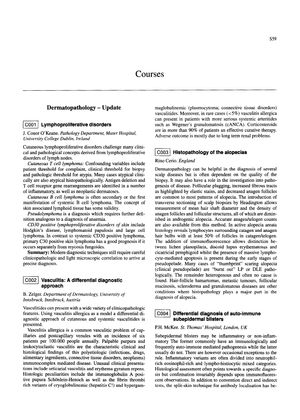Histopathology of the Alopecias
September 1997
in “
Journal of The European Academy of Dermatology and Venereology
”
alopecia androgenic alopecia alopecia areata lichen planopilaris discoid lupus erythematosus cicatricial pemphigoid pseudopelade hair-follicle hamartomas follicular mucinosis scleroderma granulomatous diseases follicular plugging fibrous tracts anagen follicles telogen phase catagen phase lymphocytes immunofluorescence transverse sectioning scalp biopsies hair loss scalp biopsy immune cells skin biopsy

TLDR Examining scalp tissue under a microscope helps diagnose and understand hair loss diseases.
The document discusses the role of dermatopathology in diagnosing various scalp diseases, particularly alopecias, and how it can contribute to understanding their pathogenesis. It highlights that common features of alopecia include follicular plugging, increased fibrous tracts, and decreased anagen follicles. The use of transverse sectioning of scalp biopsies, introduced by Headington, allows for the measurement of hair shaft diameter and the density of anagen follicles, which are reduced in androgenic alopecia. This method also provides accurate anagen/telogen counts. In active alopecia areata, histology shows lymphocytes surrounding hair bulbs with a high percentage of follicles in catagen/telogen phase. Immunofluorescence helps distinguish between lichen planopilaris, discoid lupus erythematosus, and cicatricial pemphigoid, while early stages of pseudopelade show massive lymphocyte-mediated apoptosis. Histopathology is also crucial in diagnosing other conditions causing alopecia, such as hair-follicle hamartomas, metastatic tumors, follicular mucinosis, scleroderma, and granulomatous diseases.
